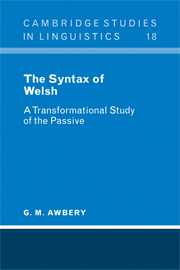4 - RESTRICTIONS ON THE PASSIVE
Published online by Cambridge University Press: 04 August 2010
Summary
Not all active sentences have a grammatical passive equivalent. In this chapter these restrictions on passives will be described and an attempt made to explain why they should appear. Section 4.1 concerns cases where the lack of a passive seems to be due to a restriction on the verb of the active sentence. Sections 4.2 to 4.5 concern cases where the lack of a passive seems to be due to a restriction on the subject or object of the active appearing as agent or subject of the passive.
Restrictions on the verb
Defective verbs Some verbs are defective. They can appear only with a very few inflections, arid lack the uninflected form of the verb completely. Such verbs are clearly not able to appear in the passive construction, or any other tenseless embedding, where the uninflected form of the verb is required for the verb of the embedded sentence. Examples of such verbs are dylai (ought he), which appears only in the imperfect or pluperfect forms, meddai (said he) which appears only in the present and imperfect forms, and moes (take) which appears only in the imperative.
Some of these verbs will be excluded on other grounds too. For instance, dylai takes a tenseless embedding as direct object, as in (1). Such forms are discussed in sections 4.2.1 and 4.2.2.
(1) Dylai Mair ddychwelyd.
Ought Mair returning.
And meddai takes a quotation from direct speech as direct object, as in (2). Such forms are discussed in section 4.2.6.
- Type
- Chapter
- Information
- The Syntax of WelshA Transformational Study of the Passive, pp. 120 - 145Publisher: Cambridge University PressPrint publication year: 1977



